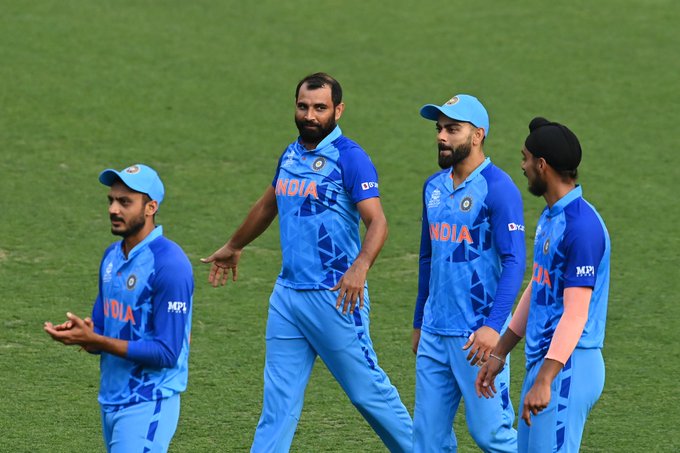Schrodinger’s Mohammed Shami: An amalgamation of contradictions
Little has been said about Mohammed Shami's inclusion in the World T20 squad as Jasprit Bumrah's replacement, despite the former's erroneous statistics in T20Is. What is it then, that is keeping his hopes on the international stage alive despite his T20I career seemingly being in the jaws of death?

Let’s not pretend Mohammed Shami is any ordinary cricketer. Leave alone debates around ethics and morals in cricket, the nonsense surrounding Mankad; if there had to be just one aspect of the sport that had to be given philosophical consideration, it would be him. The teeming 32-year-old pacer from Bengal.
Shami is who RL Stevenson was thinking of while coming up with the Duality of Man concept in Dr. Jekyll & Mr. Hyde. When William of Ockham was made India’s national selector and had to choose whether Shami should be a part of the World T20 squad, he tried to cop out by propounding a ridiculous theory. Labelling it Occam’s Razor, the idea stated that the simpler option when making a difficult choice is always the correct one. Thankfully, Ockham was immediately fired and Chetan Sharma decided to put the quick on the flight Down Under.
Currently, Shami is under the observation of Erwin Schrodinger. The physicist has placed him in an Australia-shaped box alongside a few lethal batting units. He seems to be saying something along the lines of Shami’s T20I career being both dead and alive at the same time as we speak. Wait, let’s dive into what he means by that.
A cursory glance at the right-arm fast’s numbers would lead to immediate dismissal of him being a T20 bowler of any repute, let alone one playing for the national team. Shami has an economy rate of 9.54 in T20Is and averages a ghastly 31.55. His overall T20 economy is hardly something to be proud of either, reading a disappointing 8.28. For India, the Uttar Pradesh-born seamer has just one more wicket than he has games.
Hey, but these numbers are not everything, right? There has been little doubt over Mohammed Shami’s ability with the red ball throughout his career, especially his mastery of the new ball. The veteran has been an excellent component for the Men in Blue in ODIs as well and has perhaps just not been used properly by the skippers to make use of his strongest suit.
Well, here are more statistics to dispel that myth. Shami has bowled 339 overs in the Indian Premier League in the powerplay with the new ball. His economy in that particular period does come down to a pretty decent 7.51 but the average rises to a frightening 46.3. That’s on the back of just 29 wickets in 86 innings.
How then, given all these figures, has Mohammed Shami made it to two World T20 squads in a row? In fact, the 2022 marquee event will be the bowler’s third appearance at a T20 World Cup, having also played in the 2014 edition of the tournament in Bangladesh. One could put down Shami’s inclusion to the lack of other options and injury at a critical moment to Jasprit Bumrah. However, the Indian team is enjoying an era where the IPL has been producing seamers left, right and centre, and it makes little sense to resort to a bowler with such figures for a crucial assignment.
Even if we work under the assumption that Shami is the required replacement, it does not justify the fact that Shami has not played a T20I since the World Cup last year in the United Arab Emirates. The Men in Blue have been rotating their squad heavily over the past 12 months but the quick has still not donned the Indian jersey once in the shortest format. In fact, all of Avesh Khan, Umran Malik, Umesh Yadav and Mohammed Siraj have earned opportunities to play a T20I over Shami, well and truly confirming the pacer was not in the team’s T20 plans heading into the major tournament.
Could it be that Shami made the cut because of the conditions on offer in Australia and how they would assist his particular brand of fiery bowling? On introspection, that again seems outlandish, considering India have an Umran Malik waiting in the wings. His ability to extract pace and bounce are tailormade for Australian pitches and if there is one bowler who with natural ability can wreak havoc Down Under, it is the Dale Steyn protege. Even Siraj has experience playing in Australia, albeit not in the shorter formats, and has proven he enjoys the way the pitches there behave and interact with his bowling.
Then is it the experience that gives Shami an edge? Perhaps, but that hardly seems to hold true in T20Is. Shami has just 17 caps for India, only four more than youngster Arshdeep Singh.
Wait, Schrodinger seems to be saying something about a striking anomaly in Shami’s career that has possibly propelled him to the World T20 squad; I wonder what it is.
The Gujarat Titans seamer has a track record of performing drastically better in major ICC tournaments or even high-stakes games than in general. Across the two one-day World Cups Shami has featured in, he has a stunning economy rate of 3.62 and an excellent average of 21– quite a few shades better than his career ODI economy of 5.60 and average of 25.72 respectively. As for the World T20s, there is a smaller sample set of seven games but the theory continues to hold true as the economy falls down from 9.54 to a remarkable 7.15. However, the biggest surprise comes when considering Shami’s numbers in the IPL’s post-round-robin phase.
The fast bowler has featured in seven playoff or knockout games in the tournament and managed to scalp an impressive 11 wickets. More importantly, he has bowled at an economy rate of 6 and has a world-class average of 14.72, indicating he is a different bowler altogether in crunch matches.
In fact, when one takes a closer look at Shami’s career, the bowler’s big-game pedigree becomes immediately evident. He made his debut for India in ODIs during a high-stakes third game against Pakistan at home on what was the neighbour's first bilateral tour in ages. India were pipped as the favourites in the series, earmarked as one that would pave the path for political healing, but the Men in Green had come up trumps to seal the series 2-0. They were now on the brink of a whitewash having bowled the hosts out for 167, only for Shami’s ferocious will to put a dent in proceedings. The then-youngster made the rivals reel with disciplined bowling of the highest order, managing four maidens and stunning figures of 9-4-23-1.
Then came the 2015 World Cup and Shami evolved into a beast of nature. Not even a part of the lineup in the tournament initially, Shami was roped in to cover for an injury ahead of the clash against Afghanistan. Playing in his first match of the event, he became just the second Indian bowler in history to take a hat-trick in a World Cup while finishing with a tally of four wickets. Then came England and the West Indies, who followed suit in the wake of Shami’s annihilation. While the Three Lions gave away five wickets to the searing pacer even though in a winning cause, the Caribbean encounter saw an unplayable Shami end with 6.2-0-16-4.
.png)
 Mohammed Shami's numbers on the big stage are on a completely different plane than his career figures ©
Mohammed Shami's numbers on the big stage are on a completely different plane than his career figures © Recently, Shami’s heroic streak came to light once again in the World T20 warm-up game against Australia. Warming the bench for the entire game, he was given the responsibility to defend six runs against favourites Australia in the last over. Shami duly obliged, conceding just three and plucking as many wickets out of thin air (thank you, Virat Kohli) to record a performance for the ages.
Even though the statement-making performance mattered little for India in terms of results, in the grander scheme of things with respect to the tournament, it has landed them at a crossroads. Shami bowled yorkers with eerie accuracy, something the entire Indian bowling unit has been struggling with in the absence of Bumrah. Considering his statistics in ICC tournaments and the performance against the Kangaroos, Shami apparently deserves a place in the Indian lineup come Sunday at the Melbourne Cricket Ground against Pakistan.
However, the unusual selection policy of the BCCI has made it impossible to determine who would be the best candidate for him to replace. Arshdeep Singh is likely to retain his spot solely on the basis of being India’s only left-arm seamer and to his credit, the youngster has done exceedingly well in patches for the national team. IPL starlet Harshal Patel is a bonafide death specialist, the only one India has in its squad, and has thus played the most T20Is for them since the 2021 World T20. Lastly, Jasprit Bumrah’s injury means Bhuvneshwar Kumar has by default inherited the role of India’s spearhead and is bound to be one of the first names in the team sheet.
The BCCI kept Shami waiting for his calling until it was too close for comfort, only picking him for T20Is in the month before the marquee event. Their calculations clearly backfired, with the pacer not only encountering COVID-19 but also having to be promoted to the main squad for the World Cup simultaneously.
No rational explanation exists for either Shami’s surge of positive performances on the big stage, or the BCCI’s seemingly nonsensical selection policies before major tournaments. However, if there is one bowler who can rock the boat of the opposition from out of the blue, it is Shami. And the same holds true for BCCI when it comes to taking credit for happy coincidences. Both can be best described as an amalgamation of contradictions that have in the past intertwined flawlessly when it mattered and for India’s sake, will be hoping to do so once again at the upcoming World T20.
Schrodinger, please open the box when the time has come and let us know the status of Shami’s T20I career. For now, we’ll just hope it is alive and thriving.

Comments
Sign up or log in to your account to leave comments and reactions
0 Comments